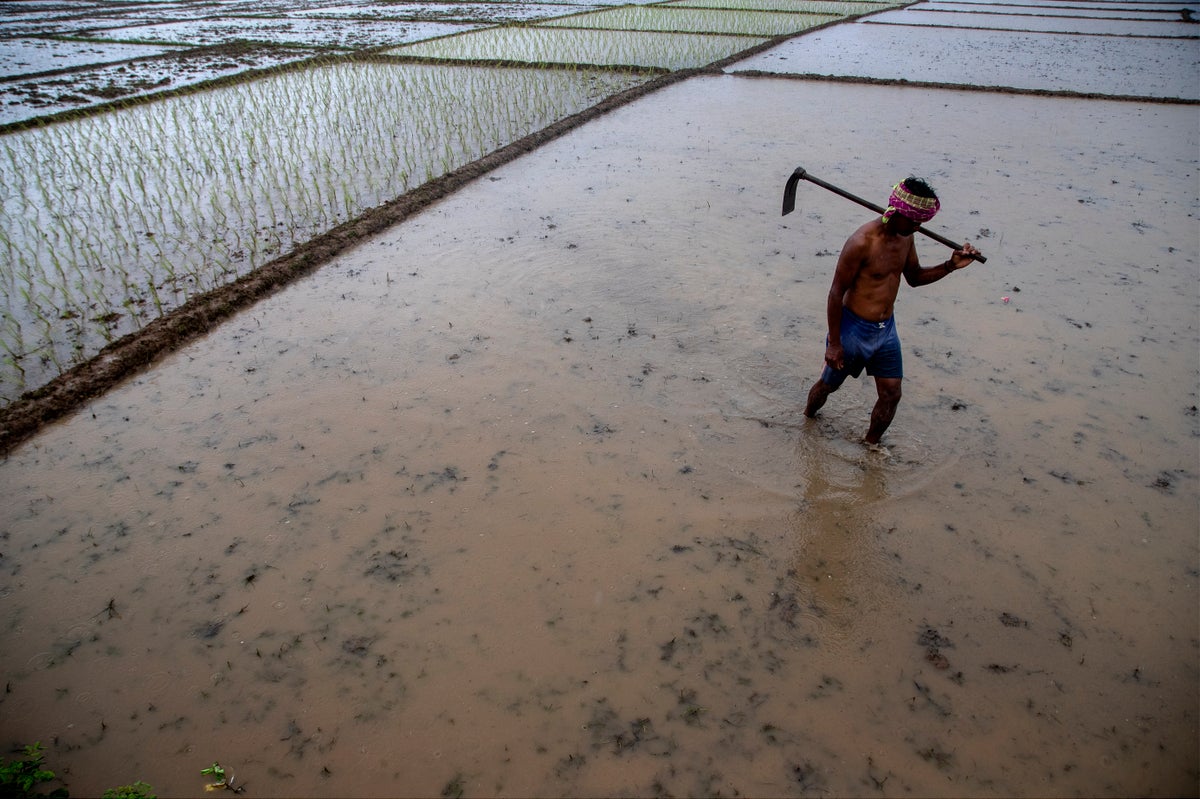
Each year from June to September, a heavy band of rain makes its way from India's southwest coast to its northeastern borders, quenching farmers' thirsty fields.
India's monsoon season is arguably the single most important weather phenomenon for the country, and a good monsoon can noticeably boost the nation's economy and the livelihoods of its 120 million farmers. But human-caused climate change is making the rainfall more erratic, making it difficult for farmers to plant, grow and harvest crops on their rain-fed fields.
“Either it rains too much within a short time or it doesn’t rain at all,” said Vijay Jawandhia, a 77-year-old farmer in western Maharashtra state. Jawandhia grows cotton, soya bean and various other crops that require a relatively cool climate and constant irrigation for the first few weeks after sowing. “We planted our cotton seeds after a good monsoon was predicted but it rained just two days and stopped after, so now we’re worried our crops will fail again.”
The Indian Meteorological Department had predicted good rainfall from the monsoon clouds earlier this year, but extreme heat in northern India stalled the rain's progress. The agency revised its predictions in June, saying the rainfall this year will be less than previously expected.
Many are looking for ways to adapt to this new, unpredictable reality. Experts suggest growing crops that need less water, better and more localized forecasting methods and protection against unexpected weather. But changing centuries-old ways of tending to the land won't be an easy task.
How is climate change affecting monsoons?
India typically has two monsoons: one from June to September moving southwest to northeast, and another from October to December going the opposite direction.
But with more planet-warming gases in the air, the rain now only loosely follows this pattern. This is because the warmer air can hold more moisture from the Indian Ocean, and that rain then gets dumped all at once. It means the monsoon is punctuated with intense flooding and dry spells, rather than sustained rain throughout.
“When it rains now, it rains heavily,” said Madhavan Rajeevan, a retired senior official at India's Ministry of Earth Sciences. Rajeevan has tracked the monsoons for decades, and has noticed “the number of rainy days is decreasing even though the total amount of seasonal rainfall has remained the same for the last century or so.”
Landslides and flooding are increasing, he said, alongside high temperatures and longer periods of drought that are adding to farmer's woes.
The flooding can also result in death and economic losses, such as the hundreds killed and the over $1.42 billion in damages in Himachal Pradesh in 2023 because of heavy monsoon rains.
Rajeevan added that hydropower resources that generate large amounts of electricity are also built with sustained rains in mind, and extreme rain and floods can lead to health issues such as increased cases of typhoid, cholera and malaria.
What does this mean for farmers?
The erratic rain is a significant blow to their livelihood.
Maharashtra has witnessed thousands of farmers dying by suicide that many say is a result of agriculture-related debt. “Our region has become infamous for this,” said Jawandhia, the farmer.
Farmers in traditionally resource-rich regions, such as Punjab and Haryana in northern India, also say they are adversely affected by both fewer rainy days and too much rain when it pours.
Tezveer Singh, a farmer in Ambala city in Haryana remembers how “entire towns and fields were flooded, hundreds of cattle died due to drowning and three people lost their lives" there in last year's flooding.
Singh grows rice, potatoes and sugarcane on his 20-acre farm and said urgent policy changes are needed to stop flood damage.
He suggested that officials can “give compensation for our losses when needed, provide climate-resilient seeds, make supply chains for farm produce more efficient and increase minimum prices for crops."
"The climate has become tough and we need to adapt,” he said.
How can they adapt?
India's weather agency makes state-level monsoon rain predictions for the entire country, but climate experts say forecasts need to be more localized in order to be useful to farmers.
Vishwas Chitale, who leads the climate resilience team at the New Delhi-based Council on Energy, Environment and Water, said making localized weather predictions and changing the times of year farmers plant their crops accordingly can help.
In many places across India, “maximum rainfall occurs in October now and not really June and July as it used to," said Chitale, who also co-authored a 2024 report looking at India’s changing monsoon patterns. "This results in a lot of crops that are waiting to be harvested getting damaged.”
He added that it's important that better forecasting is available for everyone across the country who needs it.
Some farmers are already adapting to a warmer world. In southern Kerala state, an organic farming collective has begun altering when they sow and harvest plants according to shifting rain patterns. The farming collective has also drawn up an agriculture calendar that factors in climate change that they share with other local farmers.
“The preparedness helps farmers,” said Rajesh Krishnan, a paddy farmer who's part of the collective that worked with local weather officials on the forecasts. Krishnan said their daily and weekly forecasts have an accuracy of at least 70%. “This is helping cut losses and also get a better crop. The forecasts are also helping us decide when to harvest our crops,” he said.
Climate experts like Rajeevan said the collective's model needs to be replicated across the country to allow farmers to work with the changing monsoons.
After all, he said, “monsoons are a part of our culture. We cannot think of India without monsoons.”
___
Follow Sibi Arasu on X at @sibi123







